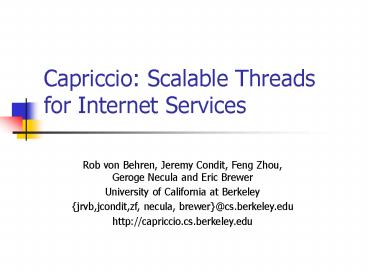Capriccio: Scalable Threads for Internet Services PowerPoint PPT Presentation
Title: Capriccio: Scalable Threads for Internet Services
1
Capriccio Scalable Threads for Internet Services
Rob von Behren, Jeremy Condit, Feng Zhou, Geroge
Necula and Eric Brewer University of California
at Berkeley jrvb,jcondit,zf, necula,
brewer_at_cs.berkeley.edu http//capriccio.cs.berkel
ey.edu
2
The Stage
- Highly concurrent applications
- Internet servers frameworks
- Flash, Ninja, SEDA
- Transaction processing databases
- Workload
- High performance
- Unpredictable load spikes
- Operate near the knee
- Avoid thrashing!
Ideal
Peak some resource at max
Performance
Overload someresource thrashing
Load (concurrent tasks)
3
The Price of Concurrency
- What makes concurrency hard?
- Race conditions
- Code complexity
- Scalability (no O(n) operations)
- Scheduling resource sensitivity
- Inevitable overload
- Performance vs. Programmability
- No current system solves
- Must be a better way!
Threads
Ideal
Ease of Programming
Events
Threads
Performance
4
The Answer Better Threads
- Goals
- Simplify the programming model
- Thread per concurrent activity
- Scalability (100K threads)
- Support existing APIs and tools
- Automate application-specific customization
- Tools
- Plumbing avoid O(n) operations
- Compile-time analysis
- Run-time analysis
- Claim User-Level threads are key
5
The Case for User-Level Threads
- Decouple programming model and OS
- Kernel threads
- Abstract hardware
- Expose device concurrency
- User-level threads
- Provide clean programming model
- Expose logical concurrency
- Benefits of user-level threads
- Control over concurrency model!
- Independent innovation
- Enables static analysis
- Enables application-specific tuning
App
User
Threads
OS
6
The Case for User-Level Threads
- Decouple programming model and OS
- Kernel threads
- Abstract hardware
- Expose device concurrency
- User-level threads
- Provide clean programming model
- Expose logical concurrency
- Benefits of user-level threads
- Control over concurrency model!
- Independent innovation
- Enables static analysis
- Enables application-specific tuning
App
User
Threads
OS
7
Capriccio Internals
- Cooperative user-level threads
- Fast context switches
- Lightweight synchronization
- Kernel Mechanisms
- Asynchronous I/O (Linux)
- Efficiency
- Avoid O(n) operations
- Fast, flexible scheduling
8
Safety Linked Stacks
Fixed Stacks
- The problem fixed stacks
- Overflow vs. wasted space
- Limits thread numbers
- The solution linked stacks
- Allocate space as needed
- Compiler analysis
- Add runtime checkpoints
- Guarantee enough space until next check
Linked Stack
9
Linked Stacks Algorithm
- Parameters
- MaxPath
- MinChunk
- Steps
- Break cycles
- Trace back
- Special Cases
- Function pointers
- External calls
- Use large stack
3
3
5
2
2
4
3
6
MaxPath 8
10
Linked Stacks Algorithm
- Parameters
- MaxPath
- MinChunk
- Steps
- Break cycles
- Trace back
- Special Cases
- Function pointers
- External calls
- Use large stack
3
3
5
2
2
4
3
6
MaxPath 8
11
Linked Stacks Algorithm
- Parameters
- MaxPath
- MinChunk
- Steps
- Break cycles
- Trace back
- Special Cases
- Function pointers
- External calls
- Use large stack
3
3
5
2
2
4
3
6
MaxPath 8
12
Linked Stacks Algorithm
- Parameters
- MaxPath
- MinChunk
- Steps
- Break cycles
- Trace back
- Special Cases
- Function pointers
- External calls
- Use large stack
3
3
5
2
2
4
3
6
MaxPath 8
13
Linked Stacks Algorithm
- Parameters
- MaxPath
- MinChunk
- Steps
- Break cycles
- Trace back
- Special Cases
- Function pointers
- External calls
- Use large stack
3
3
5
2
2
4
3
6
MaxPath 8
14
Linked Stacks Algorithm
- Parameters
- MaxPath
- MinChunk
- Steps
- Break cycles
- Trace back
- Special Cases
- Function pointers
- External calls
- Use large stack
3
3
5
2
2
4
3
6
MaxPath 8
15
SchedulingThe Blocking Graph
Web Server
Write
Read
Open
Close
Write
Read
Accept
- Lessons from event systems
- Break app into stages
- Schedule based on stage priorities
- Allows SRCT scheduling, finding bottlenecks, etc.
- Capriccio does this for threads
- Deduce stage with stack traces at blocking points
- Prioritize based on runtime information
16
Resource-Aware Scheduling
- Track resources used along BG edges
- Memory, file descriptors, CPU
- Predict future from the past
- Algorithm
- Increase use when underutilized
- Decrease use near saturation
- Advantages
- Operate near the knee w/o thrashing
- Automatic admission control
17
Thread Performance
Capriccio Capriccio-notrace LinuxThreads NPTL
Thread Creation 21.5 21.5 37.5 17.7
Context Switch 0.56 0.24 0.71 0.65
Uncontested mutex lock 0.04 0.04 0.14 0.15
Time of thread operations (microseconds)
- Slightly slower thread creation
- Faster context switches
- Even with stack traces!
- Much faster mutexes
18
Runtime Overhead
- Tested Apache 2.0.44
- Stack linking
- 78 slowdown for null call
- 3-4 overall
- Resource statistics
- 2 (on all the time)
- 0.1 (with sampling)
- Stack traces
- 8 overhead
19
Web Server Performance
20
Future Work
- Threading
- Multi-CPU support
- Kernel interface
- (enabled) Compile-time techniques
- Variations on linked stacks
- Static blocking graph
- Atomicity guarantees
- Scheduling
- More sophisticated prediction
21
Conclusions
- Capriccio simplifies high concurrency
- Scalable high performance
- Control over concurrency model
- Stack safety
- Resource-aware scheduling
- Enables compiler support, invariants
- Themes
- User-level threads are key
- Compiler techniques very promising
22
Apache Blocking Graph
23
Microbenchmark Buffer Cache
24
Microbenchmark Disk I/O
25
Microbenchmark Producer / Consumer
26
Microbenchmark pipetest

